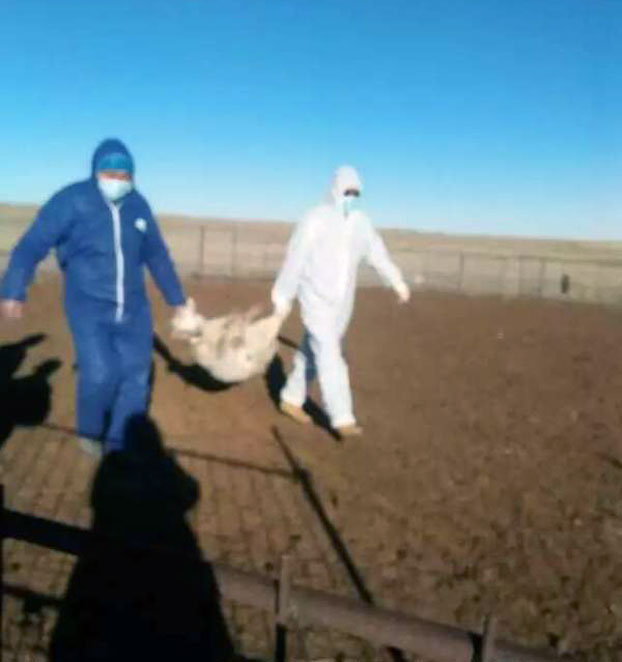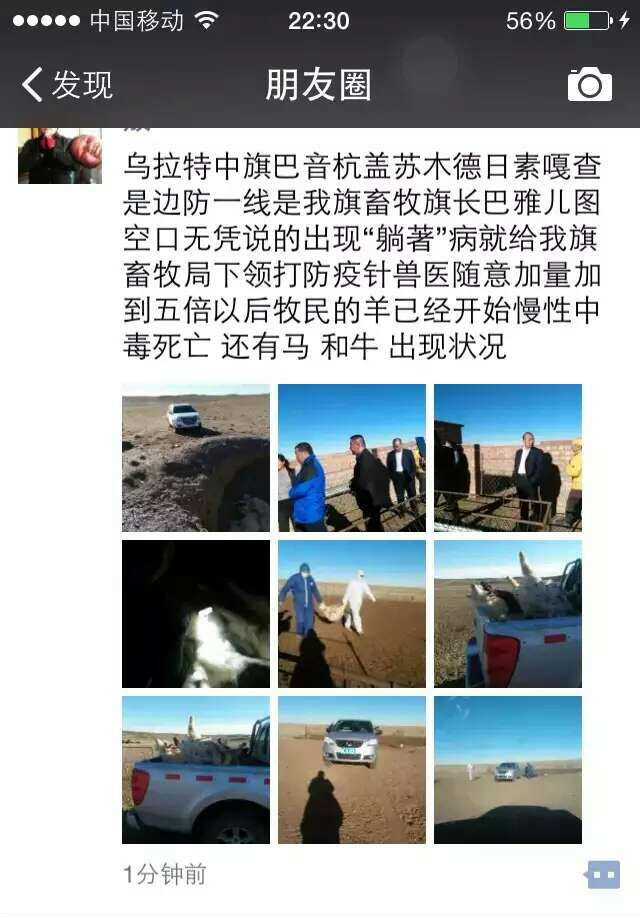Since October 23, 2015, at least
2,448 heads of livestock have
been injected with an overdose
of anthrax vaccine by the local
authorities in Bayanhangai Som,
Urad Middle Banner of Southern
(Inner) Mongolia, in fear of a
possible anthrax epidemic.
According to local Mongolian
herders, over a hundred sheep,
cattle, and horses have died
because of the overdose vaccine
and many have been sickened.
Information about the incident
is tightly concealed by the
Chinese authorities. At least
one Mongolian herder was
arrested and detained for
protesting the authorities’
intentional killing of their
livestock.
“It is very common that
livestock occasionally got
poisoned with excessive amount
of certain plants such as wild
onion (allium mongolicum),” Ms.
Odongerel, a herder from Urad
Middle Banner, told the Southern
Mongolian Human Rights
Information Center (SMHRIC),
“but this has nothing to do with
anthrax epidemic.”
“The Deputy Director of the Urad
Middle Banner Bureau of Animal
Husbandry came to our community
and ordered to inject overdose
of anthrax vaccine to our
livestock immediately upon
seeing a couple of horses that
had minor food poisoning with
wild onion,” said Odongerel in a
phone interview with the SMHRIC.
On the morning of November 3,
2015, Odongerel was taken away
by the local Public Security
Bureau and detained at the Urad
Middle Banner Public Security
Bureau Detention Center for
“spreading rumors and carrying
infected animal blood.”
“They confiscated my cell phone,
and asked me how many pictures,
video clips, and other pieces of
relevant information I have
transmitted over the Internet
about this incidence,” Odongerel
said when asked about her recent
arrest and detention. “They
accused me that I violated
certain safety policies by
carrying infected animal blood
sample.”
To disprove the authorities’
claim of an anthrax epidemic and
prove that the massive deaths of
livestock is due to an
intentional overdose of the
anthrax vaccine, local herders
attempted to dispatch Odongerel
to the regional capital, Hohhot,
to examine the blood samples
taken from the dead horses and
sheep.
“Not only did the Banner
Government refuse to take any
corrective measure, but also did
they block us from taking the
blood sample to the Inner
Mongolia Agricultural University
to have a thorough examination,”
Ms. Sarangowaa, another herder
from Urad Middle Banner told the
SMHRIC. “The government is
threatening all herders not to
answer any phone calls from
journalists about this.”
“One, they did this because they
hate us Mongolian herders and
our way of life so much. Two,
they exaggerated the situation
to ask for more money from the
higher authorities to deal with
the ‘epidemic’,” another
Mongolian herder from the
effected community told the
SMHRIC with anonymity.
As China speeds up its process
of opening up rural areas and
resettling pastoralists in
Southern Mongolia, Mongolian
herders from Urad Middle Banner
have tirelessly been protesting
the Chinese authorities’ illegal
appropriation of their grazing
lands and violation of their
legal rights. Two weeks ago, at
least nine Mongolian herders
were arrested and detained for
staging protests during the
Regional Party Secretary Wang
Jun’s visit to Urad Middle
Banner.







 Beyond
Great Walls: Environment, Identity, and Development on the Chinese
Grasslands of Inner Mongolia
Beyond
Great Walls: Environment, Identity, and Development on the Chinese
Grasslands of Inner Mongolia China's
Pastoral Region: Sheep and Wool, Minority Nationalities, Rangeland
Degradation and Sustainable Development
China's
Pastoral Region: Sheep and Wool, Minority Nationalities, Rangeland
Degradation and Sustainable Development The
Ordos Plateau of China: An Endangered Environment (Unu Studies on
Critical Environmental Regions)
The
Ordos Plateau of China: An Endangered Environment (Unu Studies on
Critical Environmental Regions)